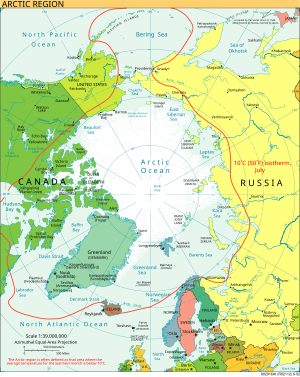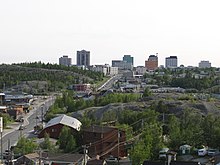Northern Canada
This article needs additional citations for verification. (December 2007) |

Northern Canada, colloquially the North, is the vast northernmost region of Canada variously defined by geography and politics. Politically, the term refers to the three territories of Canada: Yukon, Northwest Territories, and Nunavut. Similarly, the Far North (when contrasted to the North) may refer to the Canadian Arctic: the portion of Canada north of the Arctic Circle.
These reckonings somewhat depend on the concept of nordicity, a measure of northernness that other Arctic territories share. Canada, a country in northern North America whose population is concentrated along its southern frontier with the United States, is frequently reckoned to not have a 'south.' As such, the 'South' is only perceived as a region when it is contrasted to or viewed from those in the North.
Territoriality

Since 1925, Canada has claimed the portion of the Arctic between 60°W and 141°W[1] longitude, extending all the way north to the North Pole: all islands in this region are Canadian territory and the territorial waters claimed by Canada surround these islands. Views of territorial claims in this region are complicated by disagreements on legal principles. Canada and the USSR/Russia have long claimed that their territory extends according to the sector principle to the North Pole. The United States does not accept the sector principle and does not make a sector claim based on its Alaskan Arctic coast. Claims that undersea geographic features are extensions of a country's continental shelf are also used to support claims; for example the Denmark/Greenland claim on territory to the North Pole, some of which is disputed by Canada. Foreign ships, both civilian and military are allowed the right of innocent passage through the territorial waters of a littoral state subject to conditions in the United Nations Convention on the Law of the Sea[2]. The right of innocent passage is not allowed however, in internal waters, which are enclosed bodies of water or waters landward of a chain of islands. Disagreements about the sector principle or extension of territory to the North Pole and to the definition of internal waters in the Arctic lie behind differences on territorial claims in the Arctic. This claim is recognized by most countries with some exceptions, including the United States; Denmark, Russia, and Norway have made claims similar to those of Canada in the Arctic and are opposed by the European Union and the U.S.
This is especially important with the Northwest Passage. Canada asserts control of this passage as part of the Canadian Internal Waters because it is within 20 km of Canadian islands; the U.S. claims that it is in international waters. Today ice and freezing temperatures makes this a minor issue, but global warming may make the passage more accessible to shipping, something that concerns the Canadian government and inhabitants of the environmentally sensitive region.
Similarly, the disputed Hans Island (with Denmark), in the Nares Strait which is west of Greenland, may be a flashpoint for challenges to overall Canadian sovereignty in the North.
Topography (Geography)

While the largest part of the Arctic is composed of permanent ice and tundra north of the tree line, it encompasses geological regions of varying types: the Innuitian Mountains, associated with the Arctic Cordillera mountain system, is geologically distinct from the Arctic Region (which consists largely of lowlands). The Arctic and Hudson Bay lowlands comprise a substantial part of the geographic region often considered part of the Canadian Shield (in contrast to the sole geological area). The ground in the Arctic is mostly composed of permafrost, making construction difficult and often hazardous, and agriculture virtually impossible.
The Arctic watershed (or drainage basin) drains northern parts of Manitoba, Alberta and British Columbia, most of the Northwest Territories and Nunavut as well as parts of Yukon into the Arctic Ocean, including the Beaufort Sea and Baffin Bay. With the exception of the Mackenzie River, Canada's longest river, this watershed has been little used for hydroelectricity. The Peace and Athabasca Rivers along with Great Bear and Great Slave Lake (respectively the largest and second largest lakes wholly enclosed within Canada), are significant elements of the Arctic watershed. Each of these elements eventually merges with the Mackenzie so that it thereby drains the vast majority of the Arctic watershed.
Human geography

The entire region is very sparsely populated. As of 2006[update], only about 101,310 people[3] were living in a vast area larger than the size of Western Europe. It is heavily endowed with natural resources, but in most cases they are too expensive to extract and situated in an environmental context too unspoiled to be worthwhile. Though GDP per person is higher than elsewhere in Canada, the region remains relatively poor, mostly because of the extremely high cost of most consumer goods, and the region is heavily subsidised by the Government of Canada. About 51% of the population of the three territories is Aboriginal, either Inuit, First Nations or Métis.[4] The Inuit are the largest group of Aboriginal peoples in Northern Canada, and 59% of all Canada's Inuit live in Northern Canada, with Nunavut accounting for 50%.[4] The region also contains several groups of First Nations, who are mainly Chipewyan peoples. The three territories each have a greater proportion of Aboriginal inhabitants than any of Canada's provinces. There are also many more recent immigrants from around the world; of the territories, Yukon has the largest percentage of non-Aboriginal inhabitants.[5]
Recent

For hundreds of years, this area had been considered the largest 'uncivilized' area in the world. However, within the last 20 years, specifically in the last 5 years, this area has started to boom with the rest of Canada. Although it has not been on the same scale, some towns and cities have seen population increases, not seen for several decades. Yellowknife has become the centre of diamond production for all of Canada (which has become one of the top 3 countries for diamonds). That city has also seen a new change for the north: a developing skyline.
Also resulting from a diamond boom, the per capita income of the Northwest Territories is at almost $95,000.
In the Canada 2006 Census, the three territories posted a combined population of over 100,000 people for the first time in Canadian history.[3]
See also
- Arctic Circle
- Tree line
- Geography of Canada
- List of regions of Canada
- Provinces and territories of Canada
- Canadian Arctic Archipelago
- British Arctic Territories
- Operation Hurricane (Canada)
References
- ^ The Atlas of Canada - Territorial Evolution, 1927
- ^ United Nations Convention on the Law of the Sea
- ^ a b Population and dwelling counts, for Canada provinces and territories, 2006 and 2001 censuses - 100% data
- ^ a b 2001 Census Aboriginal Population Profiles
- ^ Aboriginal Identity Population, Percentage Distribution, for Canada, Provinces and Territories - 20% Sample Data from the 2001 Census
